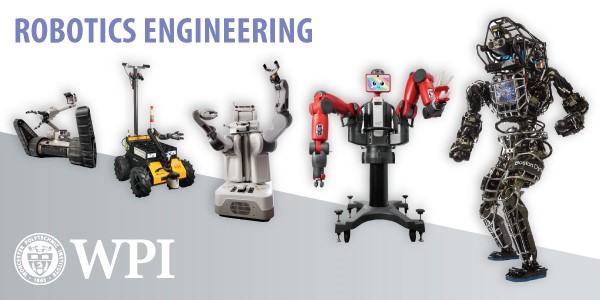RBE Masters Thesis Presentation: Aislin Hanscom | Redesign of HURON Humanoid Robot Ankle Mechanism and Weight Optimization Techniques
12:00 p.m. to 1:00 p.m.

RBE Masters Thesis Presentation
Aislin Hanscom
Redesign of HURON Humanoid Robot Ankle Mechanism and Weight Optimization Techniques
Wednesday, April 12th
12:00 PM - 1:00 PM
Unity Hall Rm 243
Abstract: This thesis proposes a new ankle design for the HURON MQP and offers weight reduction techniques to make the robot lightweight. There have been very few lightweight, full-sized, low-cost robots. The goal of HURON was to design a full-sized humanoid robot that was lightweight but also cost-effective. The first iteration of HURON was almost successful, but due to some issues with ordering parts, the ankle joint is fixed, reducing the DOF from 12 to 8. The primary objective of this research was to find what other humanoid robots have done to remain lightweight and implement a 2 DOF ankle joint. The humanoid ankle designs often utilize harmonic drives to meet the torque requirements while minimizing the size and weight constraints or are fully hydraulic.
The proposed ankle design requires minimal alterations to the existing system and relies on harmonic drives. First, by researching what other humanoid robot projects have used, we establish a baseline of the standard practices and the commonly selected components. Then based on these options and the availability of HD and budget, the proposed ankle joint was designed in SolidWorks. The design is reviewed and tested using FEA analysis to ensure it can withstand the torque and force requirements. The weight optimizations are a secondary objective to ensure that the robot's overall weight remains under 60 kg, with the addition of the upper body in the future. This weight optimization was then applied to the designed ankle mechanism to reduce the weight of the new mechanism. The ankle joint is one of the most challenging joints to develop; it experiences tremendous torque but is the tiniest joint in the lower body. Due to the size and torque constraints on the joint, the best option for the ankle is to spread the control throughout the calf, using a four-bar to control the ankle's pitch while the ankle's roll is at the center of the ankle is the most feasible implementation for HURON.
Advisor:
Professor Mohammad Mahdi Agheli Hajiabadi, Worcester Polytechnic Institute (WPI)
Committee:
Professor Andre Rosendo, Worcester Polytechnic Institute (WPI)
Professor Nicholas Bertozzi, Worcester Polytechnic Institute (WPI)
Professor William Michalson, Worcester Polytechnic Institute (WPI)